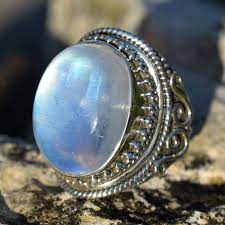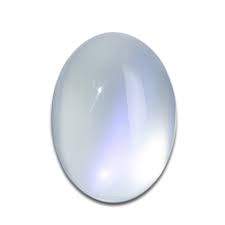Feldspars : These mystical stones
From magic to predictions of the future, discover these bewitching gems

The feldspar family is a continuous series of tectosilicates, if it is based on the same chemical composition for each crystal there are several variations within this family. Indeed, their common base is to be oxides of aluminum and sodium, some will be composed in addition to that, of calcium while others will be of potassium.
Because of their chemical composition, these stones are however quite soft, they have a hardness of 6.5 on the Mohs scale.
Feldspars have always been known to mankind and apart from their use in jewelry, their reaction to heat has led to their use (even today) as a flux for ceramics, glass work and earthenware.
Among this huge family, we can mention a few feldspars that are particularly appreciated and that are used today almost exclusively in jewelry but that, in the past, had many mystical abilities.
Moonstone :

Moonstone is an alkali feldspar microincluded with albite crystals which cause the opalescent blue highlights. Generally seen as white with blue highlights, it can also have a more gray or brown background, depending on the heat it may have been exposed to during its growth.

Like many cultures, the Hindus associated the stone with the moon. They thought it was made of solidified moonbeams. Because of its soft, milky glow, the comparison to the moon is easy to understand.
For the Romans, this stone was formed from drops of moonlight and they associated it with the symbols of femininity and intuition. They associated the stone with Diana, goddess of the moon and protector of animals.

In Greek mythology, the moonstone was associated with the goddess of the night, Nyx. It was also the stone of Selene, goddess of the full moon.
In America, the Sioux associated the stone with the goddess Hanwi, “sun of the night”. It protected the Sioux during the night, especially from evil spirits.
In popular folklore, there is the idea that if you held a moonstone in your mouth on a full moon night, you could see the future.

Known as the traveler’s protective stone, it has been used as an amulet since ancient times. It would protect the traveler, especially at night, and would be more powerful when the moon is reflected in the water.
The main deposits of moonstone are: Sri Lanka, Australia, Brazil, India, Tanzania, Madagascar, Spain, Italy, Switzerland, Burma and the United States.

Crédit photos Tadema Gallery
Sunstone:

Sunstone is potassium feldspar (potassium) and is also called oligoclase. Known for its orange glittery appearance due to hematite inclusions, it can however also be found in gem quality in one deposit: Oregon in the USA.

The warm orange color of the sunstone has always earned it the recognition of many virtues. In ancient times, these were intended to be magical. This quartz was revered by the Vikings. According to Norse mythology, possessing this stone allowed access to Valhalla, considered to be the resting place of valiant warriors who died in battle.
According to a legend, a sunstone was found near a shipwreck. According to Thorkild Ramskou, a Danish archaeologist, this is explained by the fact that this gem was once used by navigators to orient themselves at sea before the invention of the compass. To do this, they placed the stone in front of their eyes, looking up at the sky to determine the position of the sun and thus the direction they should take.
In Greece, the sun stone was believed to bring wealth, prosperity and youth. It was also used a lot in jewelry.
The Celts, who worshipped the sun, associated it with cosmic light.
The Buddhists linked it to the god Vishnu and its protective and benevolent qualities.
The deposits of the stone of sun are: India, Norway, Russia, Canada, the United States and the Czech Republic

Amazonite :

It is an alkaline feldspar, generally green, more or less turquoise, with albite needles giving it a silvery sheen.
Although its name reminds us of a famous Latin American region or a group of ancient Greek one-breasted warriors, the oldest use of this gem was discovered in the Sahara where, thanks to very dry weather conditions, archaeologists have found sites dating from the Neolithic period where the Garamantes people lived. In the mine of Eguei-Zoumma, installations for the manufacture of amazonite beads were found.
The Greek and Latin authors often evoked this old independent kingdom. Excavations have confirmed their passion for jewelry and stones and it is said that they possess, in abundance, extraordinary emeralds.

However, no ancient writing alludes to this. The mysterious Garamantic emeralds arouse a keen interest, but it is not known who was the first to speak of them, especially since no one has seen them. The great Sahara specialist, the scientific explorer Théodore Monod, born at the beginning of the 20th century, wondered about these famous emeralds. Thus, following his discovery of the amazonite mines of Eguei-Zoumma and in the absence of emerald deposits in this region, he understood that the marvelous stones of the garamantes were, in reality, only very beautiful amazonites.
In Mesopotamia, the amazonite would have been dedicated to Tiamat, goddess of the salty waters, oceans where chaos reigns. According to Babylonian mythology, she is at the origin of everything, including the first gods, born of his union with the god of fresh water.
The Egyptians already used it for its virtues as testified by a part of the text of the book of the dead, engraved on this stone, and for jewelry, as illustrated by one of the scarab rings found in the tomb of Tutankhamen.

The Greeks linked the stone to the famous Amazon warriors, whose stone was supposed to adorn their shields.
For the Navajo Indians, the stone is associated with the human creator goddess, Estsanatlehi.
The current deposits of amazonite are: Russia, Brazil, Finland, the United States, South Africa, Austria, Canada, Ethiopia and India.

Pictures credits : Tadema Gallery
Labradorite :

This is a potassium (potassium) feldspar. Labradorite is famous for its brown background and its myriad of reflections ranging from golden to midnight blue to green and purple.
Its name comes from the place where it was discovered in 1770, the coast of Labrador in Canada.
Living in a boreal and sub-arctic area, the Montagnais-Naskapi are at the origin of the legends surrounding this bewitching stone.

For them, a man would have freed the aurora borealis by breaking the rocks holding them prisoner with his spear. While the celestial lights offered an unforgettable spectacle, others froze forever in the rock. Believing that labradorite connected the terrestrial and invisible worlds, the natives believed that it contained the spirit of their ancestors.

If you are interested in feldspars, don’t hesitate to discover what Pierres de Julie has to offer in store…
We are also available for any free expertise of your jewelry, for that you can send an email with your pictures to contact@lespierresdejulie.com.
Whether you're interested in buying a piece of jewellery or a stone, a free jewelry appraisal or jewelry resale, Pierres de Julie welcomes you to its Parisian boutique in the Village Suisse, a stone's throw from the Ecole Militaire and the Esplanade des Invalides.
Nouveautés
- 2.200 €
- 2.200 €
- Unit price
- / per
- 4.950 €
- 4.950 €
- Unit price
- / per
- 4.900 €
- 4.900 €
- Unit price
- / per
- 1.400 €
- 1.400 €
- Unit price
- / per











